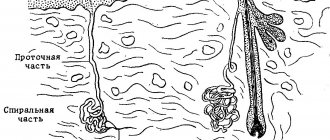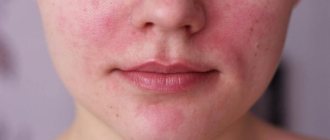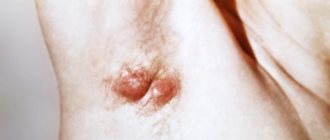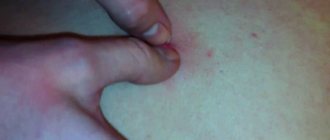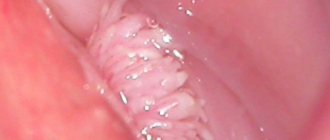In modern society, unlike earlier periods of our history, people seriously think about the state of their health and try to identify possible problems in a timely manner. To do this, you should regularly examine your body in the clinic, as well as conduct self-diagnosis. There are quite a lot of diseases that can be seen during self-examination, but to do this you need to know how they can manifest themselves.
Lipoma is a benign tumor formed from connective tissue and forms a ball filled with fat. This tumor is characterized by the absence of pain when palpated, as well as a soft structure. If you feel such a formation in yourself, you should immediately visit a doctor to identify the exact problem and decide on therapy.
Lipoma is a benign formation
On an arm or leg
Most lumps and bumps under the skin are harmless and go away without treatment. But to make a correct diagnosis and eliminate the main causes of their occurrence, you need to consult a doctor as early as possible.
A dense ball on an arm or leg is most often a lipoma (fat), fibroma or cyst.
Lipoma on arm and leg
A lipoma is a relatively soft lump of fatty tissue that grows slowly.
Fibrolipoma or fibrous lipoma is formed from adipose and connective tissue simultaneously. The lower the percentage of fat in it, the harder it is.
Fibroma on the toe and sole of the foot
Fibroma is a hard, small subcutaneous lump consisting of connective fibrous tissue.
These are all safe formations that gradually grow slowly.
A cyst is a sac under the skin filled with fluid (usually pus). Its main difference from lipoma and fibroma is that they are located deep under the skin, and the cyst is closer to the surface. All these seals usually do not require mandatory treatment, but sometimes require surgery to remove them.
A lipoma, fibroma or cyst can appear on other parts of the body. In addition to the arms and legs, they often form on the back or chest.
Lipoma treatment
There are several possible treatment options that your doctor may suggest, depending on the condition of the tumor. In some cases, if the formation is not dangerous and is located so that it does not cause discomfort to the patient, it is not removed. In this case, you must carefully monitor possible changes in the tumor and, at the slightest suspicion of growth, consult a specialist for advice.
The most reliable method is considered to be a surgical method when the wen is removed directly with its capsule. This guarantees the absence of relapse of the disease. This method is used in any medical institutions, is performed quickly and has reliable results.
Lipomas are most often removed surgically
We advise you to read: What causes wen to appear on the body
There are also more gentle and non-invasive ways to remove lipomas, which involve irradiating the formation with radio waves or destroying tumor structures using laser therapy. After this type of procedure, the body’s recovery occurs much faster than after surgical treatment, and no visible scars remain. However, such methods can only be used in the early stages of the disease and may not be performed in every medical clinic.
If the lipoma is small in size, you can get rid of it by introducing a special substance into the tissue, which destroys the structure of the fat and capsule.
After the tumor has already been removed, a histological examination of the tissue is required to exclude its malignant nature. Although lipomas do not tend to develop into cancer, the risk still exists and should be minimized.
On the face
The causes of lumps on the face that are not related to injury are most likely to be:
- Mumps (mumps) is a viral infection that mainly affects children. Lumps will be associated with inflammation of the lymph nodes of the lower part of the face;
- Allergic reaction – causes swelling in the deep layers of the skin;
- A tooth abscess can lead to swelling in the jaw area.
Enlarged lymph nodes due to mumps (left) and facial swelling due to a tooth infection (right)
A ball in a child’s cheek—it can be felt and it hurts! What is this?
The appearance of any growths or neoplasms in a child’s mouth or face always worries parents. And this is the correct reaction: along with “innocent” and completely natural phenomena, a ball in a child’s cheek or in another area of the maxillofacial zone may indicate pathological processes.
Causes and additional symptoms
Balls on the inside of a child’s cheek can form for many reasons. Among them, the most common conditions are the following:
Cyst
They wrote about it in detail here:
Cyst on the gum of a child: photos, causes, complications, treatment
This formation is a hollow capsule of connective tissue, which is filled with infected fluid, desquamated mucosal epithelium and other particles.
It can form as a result of injury or the habit of biting the cheek from the inside - through the wound that occurs at the time of injury, epithelial cells and/or infection penetrate into deeper tissues, where the growth of epithelial cells or the proliferation of microbes begins.
A characteristic symptom of a cystic formation is its complete painlessness and very slow growth. The cyst looks like a white-pink or white ball on the inside of a child’s cheek; when touched, it easily moves from side to side.
The only thing that may bother a child is discomfort due to the sensation of a foreign body in the oral cavity when the cyst reaches a significant size.
Children with malocclusions , severe dental deformations and children undergoing orthodontic treatment using fixed systems, for example, vestibular braces, which under certain conditions can injure the cheek from the inside, are most predisposed to cystic formations.
Salivary gland diseases
The excretory duct of the parotid salivary gland opens in the area of the last teeth in the upper jaw. It is here that a red ball can be found on the inside of a child’s cheek: the salivary secretion, having no outlet, accumulates in the excretory duct, gradually stretching it and forming a soft, painful formation.
The disease, as a rule, progresses quickly and without timely treatment is quickly complicated by infectious processes, mainly bacterial.
Blockage can occur under the influence of an acute inflammatory process in the salivary gland, metabolic disorders and the formation of stones in the gland, as well as as a complication of ARVI, measles, scarlet fever and other acute infectious diseases.
The clinical picture of the disease of the salivary glands is quite characteristic: the child’s body temperature rises, he complains of pain in the ear, temple and angle of the lower jaw, the skin in this area may be swollen and reddened.
Inflammation of the lymph node
The buccal lymph nodes can become inflamed due to a reaction to food poisoning, viral diseases (ARVI, influenza, herpes, etc.), as well as be a complication of long-term or acute diseases of the teeth, gums and oral mucosa.
This disease is characterized by the formation of a soft, moving ball, which can be felt both from the inside of the cheek and by palpating the face from the outside, through the skin.
When pressing on this nodule, the pain intensifies significantly, and when a secondary infection occurs, purulent processes may begin, accompanied by a sharp increase in body temperature (up to 39.5-40°C) and the formation of a fistula extending into the cheekbone area or inward into the oral cavity.
Hematoma
In case of injuries to the mucous membrane, which were not accompanied by violations of its integrity, blood from damaged vessels can escape into the tissue of the mucous membrane and coagulate there.
This results in the formation of a blood ball inside the child's cheek, which is painful for the first few hours after the injury, after which the pain gradually subsides. In the absence of infection, the hematoma goes away on its own and does not require special treatment.
When to see a doctor?
It should be understood that only a doctor can make an accurate diagnosis. Therefore, it is important to contact a specialist at the first opportunity for examination and appropriate examination.
But if you experience even one of the following symptoms, you should contact your dentist immediately:
- the child’s body temperature rose above 39.0°C;
- on the side on which the ball was found in the cheek, the face is clearly swollen, the skin feels warmer than on the other side;
- the child complains of pain in the ear, throat, head, it is difficult for him to swallow food or saliva;
- the ball quickly increases in size;
- bloody or purulent fluid is released from the ball in the cheek;
- The child has putrid or unusual breath odor.
Treatment methods
Treatment is selected taking into account the reasons for the appearance of a tumor in the cheek:
| Cause | Treatment methods |
| Cyst | It is mandatory to eliminate the cause of the cyst. For children undergoing emergency treatment with braces, it may be recommended to replace the structure with a lingual one, and in case of malocclusion and obvious injury to the cheek with their own teeth, removal of supernumerary teeth, elimination of malocclusions, etc. After this, observational treatment is prescribed: scheduled visits to the dentist, during which he assesses the dynamics of cyst growth. If the dynamics are positive, surgical removal of the cyst under local anesthesia is prescribed. |
| Salivary gland diseases | Pathologies of an inflammatory and infectious nature require antibacterial treatment, which involves the use of antibiotics for oral administration or injection. The choice of a specific drug remains with the doctor - it is important to consider the sensitivity of pathogens to the active ingredients of antimicrobial drugs or drugs from the sulfonamide group. In addition, symptomatic and immunostimulating treatment is prescribed with antipyretics, painkillers, vitamin preparations, etc. |
| Inflammation of the lymph node | Mandatory antibacterial therapy is carried out to prevent secondary infections and suppuration. If purulent complications have already arisen, surgical intervention with removal of the lymph node and tissues that have undergone pathological changes may be recommended. |
Be sure to read: Why is my child’s cheek numb in his mouth?
Source: https://vzubkah.com/sharik-vnutri-scheki-u-rebenka.html
In the groin, thighs and buttocks
The appearance of hard lumps in the vagina, on the inner thighs and on the buttocks can be caused by the following factors:
- inguinal lymph nodes are inflamed, which is a sign of infection;
- cyst - a harmless formation filled with fluid;
- an abscess is a painful collection of pus;
- genital warts - are sexually transmitted infections and are fleshy growths;
- hanging moles or warts.
Hanging mole (A), abscess (B) and genital warts with HPV (C)
On the knuckle of a finger or wrist
A subcutaneous hard ball or lump on the wrist or finger joint is most often a hygroma, a type of cyst that forms around the joints and tendons.
Hygroma (synovyl cyst) is a fairly soft, smooth ball filled with a dense jelly-like liquid. The causes of its occurrence are unknown, but most often it is associated with aging or damage to joints and tendons.
Hygroma appears near the joints
If the hygroma does not cause pain or anxiety, you can leave it or treat it yourself, but to remove it, you need to visit a dermatologist. Although often after removal, the problem may return over time.
Preventive measures
To prevent formations on the skin, you should follow the following rules:
- Adhere to proper nutrition, excluding smoked foods, fatty foods, and baked goods.
- Limiting salt.
- Rejection of bad habits.
- Selection of comfortable shoes in size made from natural materials with low heels.
- If calluses or corns often appear, use silicone insoles and inserts (before use, read the comments of specialists).
- Moderate physical activity, weight control.
- Do foot baths every evening and regularly examine the skin of your feet.
- To maintain vascular tone - a contrast shower.
- After hygiene measures, apply a rich or moisturizing cream and perform self-massage.
- Timely treatment of diseases.
- If a pathological lump is detected, consult a doctor.
General information
Subcutaneous lumps can occur spontaneously, for example, due to infectious diseases or inflammation of the lymph nodes, or from a blow. Numerous irregularities and bumps on the skin, as well as isolated ones, can occur. Infections, tumors, or the body's reaction to injury or damage can all cause swelling, lumps, or lumps on or under the skin.
Depending on the cause, the bumps may vary in size and feel hard or soft to the touch. The skin may appear red or ulcerated on the lump. Lumps may be painful or painless, depending on the cause of the injury.
Causes
There are many reasons for the appearance of various bumps on the skin and they are all directly related to skin diseases:
- Lipoma (benign tumor of adipose tissue). The lump can be any size (from a few millimeters to several centimeters). Usually painless, no change in skin color, firm to the touch.
- Mole. The lump on the skin is soft, brown or black, absolutely painless.
- Skin cancer. A lump or lump can occur in various places on the body, have a different color (from normal to dark), and is fused to the skin and surrounding tissues. Accompanied by pain and suppuration in the later stages of its development.
- Enlarged lymph nodes. The lump is located above the underlying lymph nodes, dense and hot to the touch, painful, the size of a pea to a walnut, not fused with the surrounding tissues. Combined with the presence of infection in the body (fever, intoxication).
- The cyst is intradermal. Formation of various sizes, usually of dense consistency, with unchanged skin color. Periodically it can become inflamed, even with the contents coming out.
- Skin abscess. The lump is dense and painful, the skin over it is red and hot, and there is pus inside. Combined with an increase in body temperature.
- Hemangioma. It is a red lump, soft or dense in consistency, painless.
- Warts. They are bumps or nodules of different sizes, painless or slightly painful. The skin over them may retain its natural color or acquire red tones.
- Malignant tumors of superficial structures. These formations include basal cell carcinoma, soft tissue sarcoma, neurofibromatosis, etc. Lumps and lumps can range from several millimeters to tens of centimeters. At the beginning of the disease, they are painless and do not cause much concern for the patient. Later they can become inflamed and decompose.
- Presence of foreign bodies. These are all kinds of fragments, bullets and other objects. In this case, the lump depends on the size of the foreign body, and is often painful.
- Rheumatoid nodules. They are lumps on the skin that do not manifest themselves at all. However, in addition to this, pain and deformation of the joints can be detected.
What threat does a lump under the skin pose?
Some, having discovered a lump under their skin, turn not to a doctor, but to the World Wide Web (Internet). Unfortunately, such negligence can lead to irreversible consequences and even cost someone their life. Various lumps and lumps should be a signal for you of possible danger and a reason for an immediate visit to a specialist.
What is a seal?
The lump under the skin can be detected by touch. It can be any size. The reasons for its appearance may also be different. The sooner treatment is started, the faster the discomfort will pass. There are several types of such seals:
How does the disease progress?
The compaction under the skin can be either single or multiple. They differ in size, color and cause. Their appearance does not depend on age and gender.
How does the treatment work?
Lumps and lumps are removed surgically. The doctor removes the growth with the capsule, and in cases of cancer, along with the surrounding tissues.
If it is not life-threatening, then treatment may not be carried out, for example, a lump under the skin on the back, face in the form of moles, lipomas or small cysts. Warts are removed using fresol. He burns it out without leaving marks on the skin. Any questions should be addressed to a therapist. He will do an examination and give a referral to an oncologist, surgeon, dermatologist, and so on.
Small hard ball under the skin
A hard ball under the skin may turn out to be a fibrous lipoma - a mobile seal consisting of fat and connective tissue that grows. An ordinary lipoma (fat) consists only of adipose tissue, therefore it is softer. And fibrous is more dense due to connective tissue. Sizes vary from a pea to several centimeters in diameter. Lipomas are safe.
If the ball turns out to be not a lipoma, then most likely it will be a cyst - a sac under the skin filled with pus. They are very similar, but the important difference is that the cyst will be closer to the surface and usually goes away without treatment.
Ball inside the cheek: how dangerous is it?
The reason for an unscheduled visit to the dental clinic can be not only severe toothache, but also the appearance of a ball inside the cheek. Such a neoplasm can arise for several reasons - due to simple rubbing of soft tissues or due to the development of certain pathological processes.
Patients note that the lump may be mobile and painful, but often its appearance is not accompanied by such symptoms. Why does a ball appear in the mouth, and why is it dangerous? This question is popular not only in the doctor’s office, but is also very common among visitors to thematic forums on the Internet, so it is necessary to familiarize yourself with the main causes of growths.
Development of complications of dental diseases
A hard ball inside the cheek often appears during the development of inflammatory processes. They are caused by complications of caries - pulpitis, periodontitis. A similar problem arises if such diseases were treated poorly. A focus of infection remains at the root of the tooth, the process spreads to the pulp chamber, then affects the soft tissue of the gums and cheeks.
It is then that pus begins to accumulate and a visible lump appears. At first it is small in size, then it increases, spreading to the entire area of the cheek and part of the neck. The process is accompanied by severe swelling and pain.
This complication should not be ignored or self-medicated. Dentists perform a surgical opening of the lump (under local anesthesia), treat its cavity with antiseptics, and stitch up the wound. The patient is prescribed medication - anti-inflammatory, antibacterial agents (for internal use and local action).
Pathologies of the sebaceous gland
The human oral cavity contains sebaceous glands. In some cases, they become blocked, and then fat begins to accumulate under the mucous membrane inside the mouth.
Decreased immunity, inflammatory processes, lipid metabolism disorders in the body, mechanical injuries and other prerequisites can lead to the appearance of a rolling ball inside the cheek. Doctors define it as a lipoma; in everyday life it is called a wen.
The process of its formation and growth can take different periods of time - from a week to several years.
There is a high probability of developing an inflammatory process inside the wen. If the situation begins to develop according to this “scenario”, pus will form and accumulate inside its capsule, pain will appear, accompanied by an increase in body temperature, and the appearance of general weakness in the patient.
The lipoma must be removed surgically. The procedure is performed by a dentist. In most cases, the neoplasm tissue is sent for histological examination.
Ball inside cheek photo
The appearance of a ball or cyst on the cheek inside the oral cavity can occur as a result of infections or injuries to the salivary gland. The Stenon duct (located near the human ears) is blocked by a plug consisting of organic particles - bacteria, blood, pus.
A person experiences a noticeable deterioration in health, one of the manifestations is the growth of a lump. When touched, her body has a soft structure; manipulation is not accompanied by pain. Such a pathological process cannot be left without medical attention.
After confirming the diagnosis, the patient is prescribed treatment - antiseptic treatment of the internal surfaces of the mouth, antibiotic injections (intramuscularly or into the salivary gland itself) or surgery to restore the salivary duct.
Mechanical damage
Many people have a ball in their cheek that hurts due to normal tissue trauma. The inner mucous membrane of the cheek can become damaged due to improper bite or teeth growth. If a person bites his cheek once, he will notice that an ulcer with swelling or swelling has appeared at the site of injury. This symptom usually lasts up to two days, then goes away on its own.
If any infection gets into the wound or a decrease in immune defense is observed, a person may develop a pathological process. It is this that is accompanied by an increase in the size of the “ball” and the appearance of painful sensations. The occurrence of a pathological process inside the mouth (on the gum or cheek) may be a consequence of tooth extraction or prolonged eruption of “special” teeth – wisdom teeth.
Attention!
The consequences of mechanical impact on the mucous membranes should be assessed by the dentist. He prescribes medication and, in some situations, performs surgery to open the tumor.
Hard balls under the skin due to ingrown hairs
Under certain conditions, not all of the hair is shaved off; part of it remains under the skin and cannot break through, so it bends and grows inside the hair follicle. This is how ingrown hairs appear, they cause inflammation, pain and form small hard balls in the shaving area. Most often this is the chin, back of the head, armpits and pubic area. Sometimes an ingrown hair can become an enlarged lump (cyst) after infection.
Ingrown hairs
Warning symptoms
In some cases, going to the doctor for self-reassurance about subcutaneous balls can be frustrating. But consultation with a specialist is essential if the appearance of a tumor is accompanied by the following symptoms:
- the ball hurts when pressed;
- formation is solid, with unclear boundaries;
- the skin over the tumor has changed color;
- local hyperemia is observed;
- purulent contents are visible under the skin;
- the tumor in the form of a ball increases in size;
- the lump is bleeding;
- the skin over the ball becomes covered with a dark crust (necrosis);
- when palpated, a strong fusion with the tissues is felt;
- similar elements appear in other places;
- the tumor appeared suddenly and does not go away for more than 7 days.
READ ALSO: How can you get rid of blackheads quickly and effectively?
These symptoms do not always indicate something terrible, but, on the other hand, serious diseases are often detected in later stages precisely because of the absence of frightening manifestations.
Pimples have turned into hard balls
Pimples are places where the skin becomes inflamed. They appear when dead skin cells, sebum and bacteria clog the pores, forming hard balls. Acne (acne) is a common problem among teenagers, but can appear at any other age. Bacteria multiply quickly under the skin and this leads to the appearance of new acne.
There are different types of acne: pimples, papules, pustules, cysts or nodules, so there is no one way to treat acne. In severe cases of the disease, tablets and local treatment are prescribed.
If the acne is large, then laser and phototherapy, drainage and steroid injections are performed to reduce swelling.
Lump under the skin after vaccination
Vaccination is a reliable way to protect against infections without causing serious side effects. But some children experience various symptoms after vaccinations, such as:
- fever within 2-3 days after vaccination;
- redness at the injection site;
- a dense area at the injection site (in this case, a cold compress will help);
- a rash in the form of red dots may cover the child from head to toe, but it is harmless and will go away within a week;
- in rare cases, the entire vaccination area may become red, swollen, and hot (pain reliever and hydrocortisone ointment will help).
A hard lump under red or blue skin
If the skin around the lump is red or blue, it may be an abscess - a swollen area that contains a build-up of pus. A skin abscess is a lump usually surrounded by discolored skin.
The vast majority of abscesses are caused by infection. Inside they are full of pus, bacteria and dead skin cells. Abscesses are often painful and warm to the touch and can occur on any part of the body. However, the most common sites of occurrence include the skin of the armpits, around the anus, in the groin and around a tooth.
To effectively treat an abscess, it must be opened. Unlike other bacterial infections, antibiotics alone will not help. In rare cases, an abscess may open on its own, but most often it will need to be helped with a warm compress. If done incorrectly, it can lead to bruising.
Unjustified actions
When a person notices that a tumor has appeared on his neck, he should avoid the following actions:
- You should not try to open it yourself, there is a risk of infection and worsening the situation.
- There is no need to warm the formation or apply heat to it. If the cause of its occurrence is an inflammatory process, then such treatment will accelerate the spread of infection and increase the ball in size.
- If you have cancer, it is also not recommended to warm yourself.
- You should not burn with iodine, brilliant green, burn with potassium permanganate or vinegar - as a result of such an effect, marks will remain on the skin.
- Compresses with ointments and lotions with decoctions of medicinal herbs will not help.
Source: gribkovye-zabolevaniya.com
Related questions:
| date | Question | Status |
| 10.11.2015 | Infection at the dentist Hello, I have the following question for you. My husband had a severe toothache. He works late, so it’s hard to get to the dentist. When my cheek was already swollen, after work we went to the doctor on duty at the city clinic, the doctor simply opened the tooth and prescribed rinses. The doctor was very young. And he even mixed up the tooth. He sent me for an X-ray with the wrong tooth number, after which the tooth was treated, the canals were cleaned and a filling was placed. The swelling in my cheek went away, but the pain remained a little. (all this was at the end of October), somewhere... | 3 ANSWERS |
| 24.01.2017 | Cough does not go away for a long time Hello. I’ve been treating a cold for two weeks now, I’m getting better and sometimes worse. I have been lying at home for the third day now, my general condition has improved, but the swollen tonsils do not go away, I have an infrequent cough, I do not cough well, but a little sputum comes out. Yesterday there was no temperature, today it is 37 degrees. I drink mucoltin, breast milk, syrup and throat lozenges. I don’t go to the doctor because I don’t want to spend half a day in the clinic. There are swollen tonsils in the neck and it hurts to press on the sides of the neck. Tell me, maybe I'm drinking wrong... | 1 REPLY |
| 05.07.2018 | Headaches and lymph nodes in a child, what to do? My 7-year-old child has lymph nodes protruding from the back of his neck. They don't hurt unless you press hard. We took a finger prick blood test and a urine test at the clinic. The pediatrician looked at the tests and said everything was normal. What do you recommend doing? Which doctor should I contact and what other tests can I get? He also often has headaches, sometimes it’s very strong in the fall, sometimes it’s pulsating in the background of the year. How to treat or examine? | 1 REPLY |
| 03.07.2016 | Enlarged lymph nodes Hello! 2 days ago I noticed enlarged lymph nodes on the neck and armpit on the right side, and the gums inside were also swollen on the right side. Today my temperature rose to 37.1 and I felt weak. Can lymph nodes in different places become enlarged during a cold? The other day I was very cold. I read that such enlarged lymph nodes can be due to oncology, I am very worried about this. I will be very grateful for your answer! | 1 REPLY |
| 24.05.2017 | Enlarged lymph nodes Please! Help! I am very worried. My lymph nodes were enlarged at the beginning of May, on my neck and behind my ear. I went to the doctor, they said my throat was loose, but there was no fever, my condition was normal, only snot was running down the back of my throat. I did an ultrasound, they said that it was just a cold enlargement of the nodes, but it was normal. I was prescribed Augmentin and took it for 7 days. Until May 16. The knot behind the ear seems to have gotten smaller. After 2 or two I felt bad. And the knot seemed to have grown again. Today is May 24th. Now see a doctor only through... | 1 REPLY |
Source: SprosiDoktora.ru
